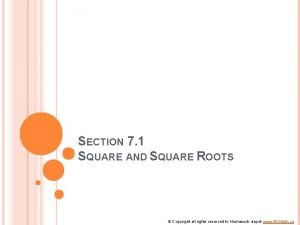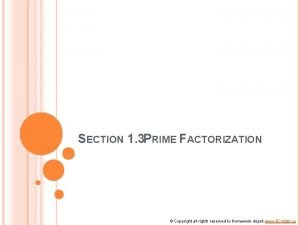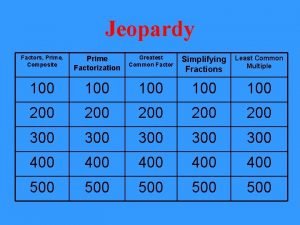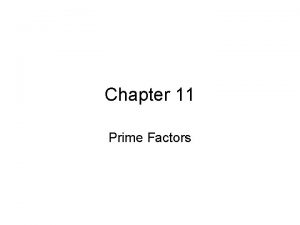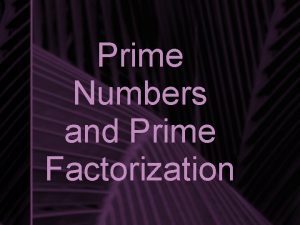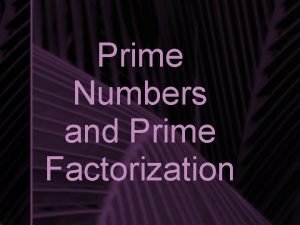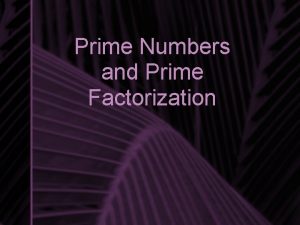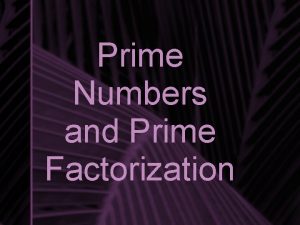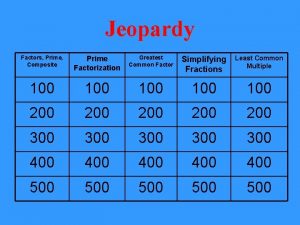4 1 Factors and Prime Factorization Learn to















- Slides: 15

4 -1 Factors and Prime Factorization Learn to write prime factorizations of composite numbers.

4 -1 Factors and Prime Factorization Vocabulary factor prime factorization

4 -1 Factors and Prime Factorization Whole numbers that are multiplied to find a product are called factors of that product. A number is divisible by its factors. 2 3=6 Factors Product 6 ÷ 3 = 2 6 ÷ 2 = 3 6 is divisible by 3 and 2.

4 -1 Factors and Prime Factorization Helpful Hint When the pairs of factors begin to repeat, then you have found all of the factors of the number you are factoring.

4 -1 Factors and Prime Factorization Additional Example 1 A: Finding Factors List all of the factors of the number 16. A. 16 16 = 1 • 16 16 = 2 • 8 16 = 4 • 4 16 = 8 • 2 1 2 4 4 1 2 3 4 5 6 7 8 is a factor. is not a factor. and 2 have already been listed so stop here. 8 16 You can draw a diagram to illustrate the factor pairs. The factors of 16 are 1, 2, 4, 8, and 16.

4 -1 Factors and Prime Factorization Additional Example 1 B: Finding Factors List all of the factors of the number 19. B. 19 19 = 1 • 19 19 is not divisible by any other whole number. The factors of 19 are 1 and 19.

4 -1 Factors and Prime Factorization Check It Out: Example 1 A List all of the factors of the number 12. A. 12 12 12 = = 1 2 3 4 • • 12 6 4 3 1 is a factor. 2 is a factor. 3 is a factor. 4 and 3 have already been listed so stop here. 4 6 12 You can draw a diagram to illustrate the factor pairs. The factors of 12 are 1, 2, 3, 4, 6, and 12

4 -1 Factors and Prime Factorization Check It Out: Example 1 B List all of the factors of the number 11. B. 11 11 = 1 • 11 11 is not divisible by any other whole number. The factors of 11 are 1 and 11.

4 -1 Factors and Prime Factorization You can use factors to write a number in different ways. Factorization of 12 1 • 12 2 • 6 3 • 4 3 • 2 Notice that these factors are all prime. The prime factorization of a number is the number written as the product of its prime factors.

4 -1 Factors and Prime Factorization Helpful Hint You can use exponents to write prime factorizations. Remember that an exponent tells you how many times the base is a factor.

4 -1 Factors and Prime Factorization Additional Example 2 A: Writing Prime Factorizations Write the prime factorization of 24. Method 1: Use a factor tree. Choose any two factors of 24 to begin. Keep finding factors until each branch ends at a prime factor. 24 2 • 6 12 • 6 2 • 3 3 • 2 4 2 • 2 24 = 3 • 2 • 2 24 = 2 • 2 • 3 The prime factorization of 24 is 2 • 2 • 3, or 23 • 3.

4 -1 Factors and Prime Factorization Additional Example 2 B: Writing Prime Factorizations Write the prime factorization of 45. Method 2: Use a ladder diagram. Choose a prime factor of 45 to begin. Keep dividing by prime factors until the quotient is 1. 3 45 5 15 3 5 5 1 45 = 3 • 5 45 9 3 3 3 1 45 = 5 • 3 The prime factorization of 45 is 3 • 5 or 32 • 5.

4 -1 Factors and Prime Factorization In Example 2, notice that the prime factors may be written in a different order, but they are still the same factors. Except for changes in the order, there is only one way to write the prime factorization of a number.

4 -1 Factors and Prime Factorization Check It Out: Example 2 A Write the prime factorization of 28. Method 1: Use a factor tree. Choose any two factors of 28 to begin. Keep finding factors until each branch ends at a prime factor. 28 2 • 28 14 2 • 7 7 28 = 2 • 7 • 4 2 • 2 28 = 7 • 2 The prime factorization of 28 is 2 • 7, or 22 • 7.

4 -1 Factors and Prime Factorization Check It Out: Example 2 B Write the prime factorization of 36. Method 2: Use a ladder diagram. Choose a prime factor of 36 to begin. Keep dividing by prime factors until the quotient is 1. 3 36 3 12 2 3 12 3 6 2 36 4 2 3 1 36 = 3 • 2 • 3 2 2 1 36 = 3 • 2 • 2 The prime factorization of 36 is 3 • 2 • 3, or 32 • 23.
 Hcf lcm worksheet
Hcf lcm worksheet Gcf of 34
Gcf of 34 Factorization of 162
Factorization of 162 2352 prime factorization
2352 prime factorization All the perfect squares
All the perfect squares 120 prime factorization
120 prime factorization Factor tree for 64
Factor tree for 64 Is 121 prime or composite
Is 121 prime or composite Whats a prime factor
Whats a prime factor Prime of 72
Prime of 72 Prime factorization 5th grade
Prime factorization 5th grade Quantum prime factorization
Quantum prime factorization Prime factorization of 630
Prime factorization of 630 Highest common factor
Highest common factor Prime factorization of 200
Prime factorization of 200 Gcf of 10 and 12
Gcf of 10 and 12




